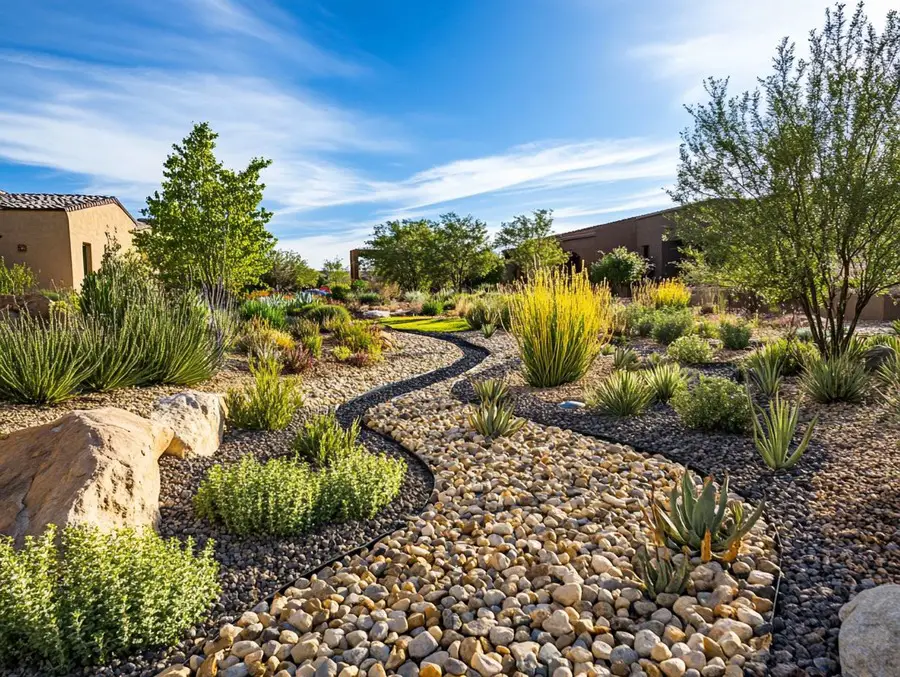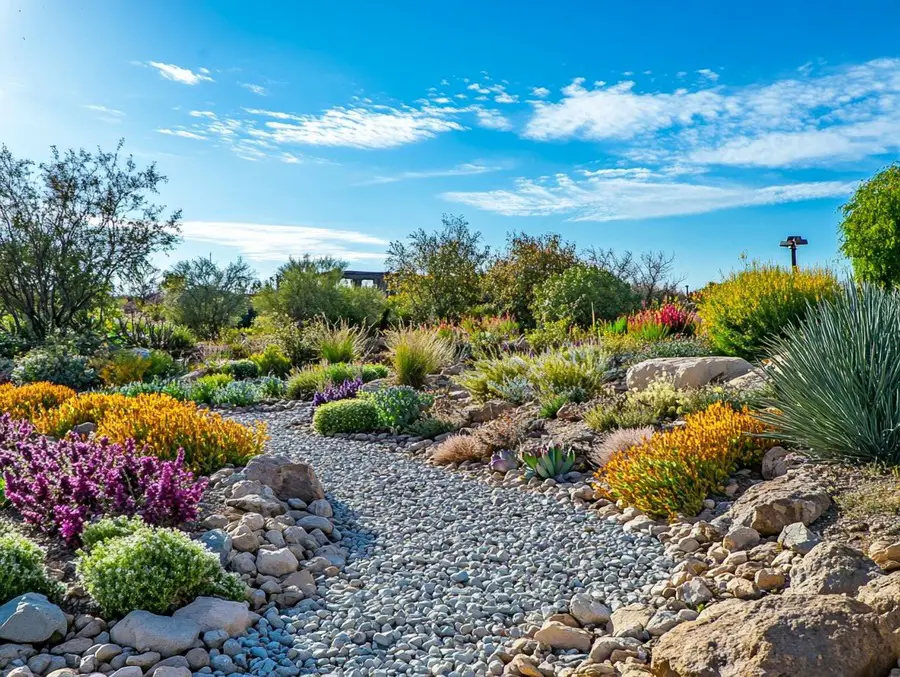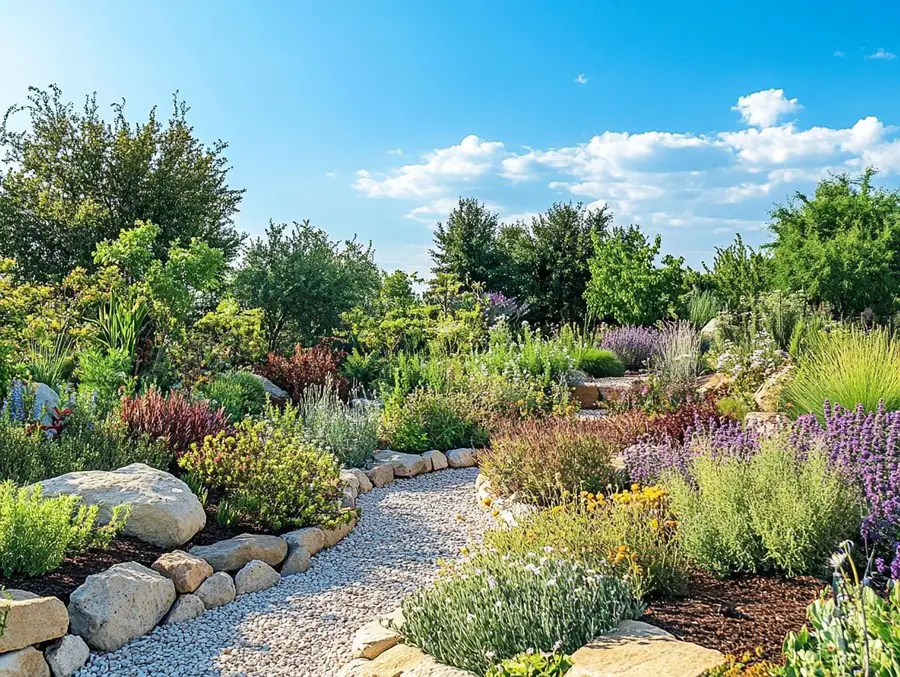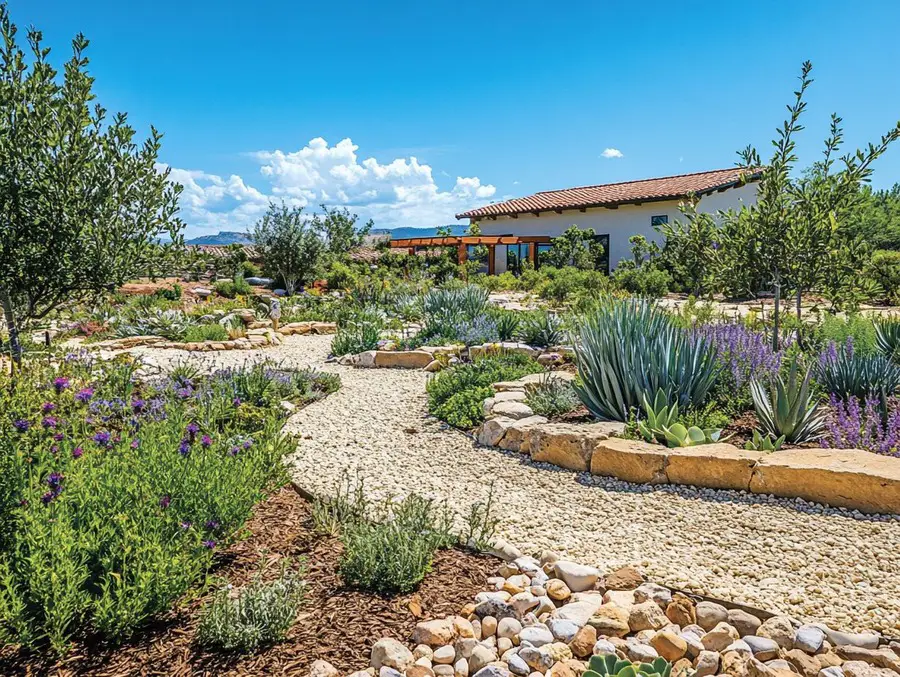
Xeriscaping is a smart and sustainable way to landscape, and by following the 7 principles of xeriscaping, you can conserve water and create a vibrant outdoor environment.
Xeriscaping is a smart and sustainable way to landscape that helps you cut down on water use while still making your outdoor space look beautiful and functional.
By following seven key principles, planning wisely, improving your soil, choosing drought-resistant plants, and using efficient irrigation techniques, you can conserve precious water resources and create a vibrant outdoor environment.
This article breaks down the fundamental principles of xeriscaping and the environmental and economic benefits it offers and gives you practical steps to turn your landscape into a water-efficient haven.
Dive in to see how you can make a positive impact on your garden and the planet.
What Are the 7 Principles of Xeriscaping?

Xeriscaping is your go-to approach for sustainable gardening, focusing on water conservation by using drought-tolerant plants and smart landscape design techniques that fit xeric environments.
The 7 Principles of Xeriscaping
- Planning and Design: Create a thoughtful layout that maximizes water efficiency and considers plant placement, sun exposure, and soil type.
- Soil Improvement: Enhance soil with organic matter and test for drainage to support drought-tolerant plants.
- Efficient Irrigation: Use drip irrigation or soaker hoses to deliver water directly to plant roots, minimizing waste.
- Appropriate Plant Selection: Choose native and drought-resistant plants suited to your climate and soil conditions.
- Mulching: Apply mulch to retain soil moisture, regulate temperature, and reduce weed growth.
- Turf Reduction: Minimize traditional lawns by replacing them with ground covers, hardscapes, or drought-tolerant grasses.
- Maintenance: Regularly weed, prune, and monitor irrigation to ensure long-term water savings and plant health.
These principles create a sustainable, low-water landscape that’s beautiful and eco-friendly!
This practice not only promotes eco-friendly gardening but also gives you a beautiful, low-maintenance solution if you want to cut down on your carbon footprint while sprucing up your outdoor space.
The 7 principles of xeriscaping-Colorado State University
By incorporating native plants and getting to know your soil types, you can create a lively landscape that thrives in your local climate, helping you manage water resources wisely and boost biodiversity.
In terms of xeriscaping, the key components involve planning strategically to minimize water usage.
Think proper site analysis and efficient irrigation systems.
Choosing drought-resistant plants that are a perfect match for your local environment not only saves water but also means less upkeep, which is a win for both you and nature.
Xeriscaping improves ecological integrity by providing habitats for local wildlife, enhancing soil health, and preventing erosion.
This environmentally friendly approach shows your commitment to sustainability while allowing you to enjoy a visually appealing garden, even in the face of water scarcity.
The Principles of Xeriscaping
The principles of xeriscaping are your go-to guidelines for effective water management, improving soil health, and creating sustainable landscapes that need minimal irrigation while looking great and being eco-friendly.
By focusing on enhancing your soil, choosing the right plants, and using efficient irrigation practices, you can create a landscape that not only thrives in a dry environment but also helps with climate adaptability and long-term success.
1. Planning and Design
Effective planning and design are key to nailing xeriscaping. Start with a thorough site analysis to figure out your microclimates, soil types, and what vegetation you already have in place.
By carefully planning your garden layout, you can group plants with similar water needs and place them where they’ll get the right amount of sunlight.
This way, you’ll boost irrigation efficiency and cut down on water use.
Understanding the topography of your area can really influence how drainage patterns and moisture retention work, which is crucial for picking the right plant species.
Take some time to assess how sunlight hits different spots throughout the day.
This will help you figure out which areas might be too shaded or getting too much sun, allowing for a more thoughtful arrangement.
Don’t forget to consider existing ecosystems; they can give you great insights into native plants that are already well-suited to your local climate.
For smart resource management, it’s a good idea to create distinct zones in your garden where plants with similar hydration needs can flourish, ensuring your watering efforts are both focused and efficient.
2. Soil Improvement
Improving soil health is key when you’re diving into xeriscaping. It boosts water retention, supports plant growth, and cuts down on the need for those chemical fertilizers you want to avoid.
By getting to know the different soil types and using organic amendments, you can create a fertile environment that nurtures both xerophytic plants and native species while making sure there’s effective drainage too.
One great method to consider is composting, which really amps up the soil with essential nutrients and can significantly increase organic matter levels.
And don’t forget about organic mulches! They help retain moisture, suppress weeds, and regulate soil temperature, giving your plant roots an extra layer of protection.
Using specific soil amendments tailored to your existing soil type can help balance pH levels and improve texture, making it easier for your plants to hold onto water and get the nutrients they need.
Understanding the unique characteristics of your soil is crucial, as it directly impacts which plants are going to thrive in your landscape.
By adopting these sustainable practices, you’ll be contributing to a much healthier ecosystem.
3. Appropriate Plant Selection
Choosing the right plants is key when you’re xeriscaping. By picking drought-tolerant and native plants, you can boost biodiversity and make sure your landscape fits well with the local climate and soil conditions.
If you take the time to understand plant hardiness zones and group your plants based on their water and sunlight needs, you can create a resilient garden that thrives no matter the season.
It’s a smart move to focus on species that are not only drought-resistant but also tough enough to flourish in challenging environmental conditions.
Native plants, for example, have evolved to handle local weather fluctuations, so they require minimal maintenance and irrigation.
Think about arranging your chosen plants according to their growth habits and moisture needs.
This way, you’ll not only keep them healthy but also add some visual interest with varied heights and textures.
Make sure to space them out properly to allow for good air circulation, which helps reduce the risk of disease and promotes healthier foliage.
With a bit of thoughtful planning, you can create a beautiful landscape that conserves water and supports local wildlife.
4. Efficient Irrigation

Implementing efficient irrigation techniques is key for you to maximize water management and keep your xeriscape looking lush and vibrant, even when the weather gets dry.
Using methods like drip irrigation not only saves water but also sends moisture straight to the roots, which promotes healthier plants and cuts down on evaporation.
You can take it a step further by incorporating strategies like rainwater harvesting systems to enhance sustainability.
This way, you can capture and make use of natural rainfall.
Establishing a well-planned watering schedule that fits your plants’ needs while taking into account local weather conditions will help you achieve optimal moisture levels without wasting water.
Utilizing timers and moisture sensors can also help maintain the right balance, ensuring that your xeriscape thrives without putting too much pressure on the ecosystem.
By thoughtfully integrating these practices, you can cultivate a resilient landscape that flourishes in harmony with its environment, showcasing both beauty and responsible water usage.
5. Mulching
Mulching is a game-changer in xeriscaping that helps you retain soil moisture, prevent erosion, and keep those pesky weeds at bay, all while boosting the health of your landscape.
By choosing the right types of mulch, like organic mulch or gravel, you can support your plants and contribute to soil improvement and water conservation.
You’ve got several options to consider, from straw to wood chips to cocoa hulls, each with its own set of perks.
Organic mulches like wood chips break down over time, enriching your soil with nutrients, while non-organic choices like gravel excel at moisture retention without breaking down.
Proper application is key here so aim for a layer of 2-4 inches to get the most bang for your buck without suffocating those plant roots.
When you mulch correctly, it doesn’t just conserve moisture. It also helps create a sustainable ecosystem by moderating soil temperature and encouraging beneficial microorganisms.
6. Proper Maintenance
Proper maintenance practices are key to the long-term success of your xeriscaping project.
They help ensure your garden stays healthy and visually appealing while also being kind to the environment.
By setting up a regular maintenance schedule and using effective pest management strategies, you can keep your xeriscape vibrant and thriving through every season.
In terms of watering, adjust your schedule based on rainfall and focus on deep watering techniques to encourage those roots to grow deep.
Don’t forget about periodic pruning. It will help shape your plants and improve air circulation, which is super important for keeping fungal issues at bay.
Watch pest populations through integrated pest management; this way, you can prevent infestations without relying on harsh chemicals.
Seasonal clean-up activities, like removing debris and dead plant material, are also crucial to maintaining the look and health of your xeriscape.
And remember, always tailor your maintenance efforts to your local climate conditions and the specific needs of your plants for the best results.
7. Use of Sustainable Materials and Eliminate Turfgrass
Utilizing sustainable materials in your xeriscaping projects doesn’t just boost your garden’s ecological integrity.
It also supports environmental sustainability and smart resource management.
By choosing materials that minimize environmental impact and promote energy efficiency, you can really cut down your landscape’s carbon footprint.
Think about incorporating recycled resources like reclaimed wood or repurposed stones.
Not only does this help reduce waste, but it also adds a unique character to your landscape design.
Using organic products, like natural fertilizers and pest control methods, helps create a healthy ecosystem that thrives without the need for harmful chemicals.
Adopting environmentally friendly construction practices, like permeable paving, can effectively manage stormwater, reducing runoff and improving water quality.
These thoughtful choices can result in a garden that’s not just visually stunning but also resilient, supporting local biodiversity and encouraging natural habitats.
Benefits of Xeriscaping
The benefits of xeriscaping go way beyond just saving water; they include a bunch of environmental and economic perks that boost climate resilience, create habitats, and improve your quality of life in urban areas.
By adopting sustainable landscaping practices, you can design beautiful green spaces that not only look good but also support biodiversity and lower your maintenance costs.
Environmental and Economic Advantages

The environmental and economic benefits of xeriscaping are pretty impressive.
It offers great solutions for water retention, controlling soil erosion, and cutting down on the need for chemical fertilizers.
When you adopt xeriscaping practices, you’re not just doing a solid for the environment, but you’re also saving a nice chunk of change on your water bills and maintenance costs.
Xeriscaping helps improve water quality by reducing runoff and filtering out pollutants.
This means it plays a key role in preserving local ecosystems and boosting biodiversity by providing homes for various native species.
You’ll notice that native plants typically need much less water and are better suited to your local climate, which means you can cut back on irrigation and save energy, too.
On the economic side, this game-changing approach not only slashes your water bills but also trims landscaping costs, making your community more sustainable and eco-friendly.
By emphasizing these practices, you’re setting yourself up for long-term benefits that benefit both you and the environment.
Implementing Xeriscaping in Your Landscape
Implementing xeriscaping in your landscape can really transform your outdoor space into a sustainable and visually appealing environment.
Plus, it encourages community engagement and environmental education.
By following a step-by-step guide, you can design your garden in a way that supports biodiversity and optimizes water use.
Imagine creating a thriving ecosystem right in your backyard!
Step-by-Step Guide and Tips
A step-by-step guide to implementing xeriscaping techniques can really help you create a garden that thrives while maximizing water efficiency and minimizing your environmental impact.
Start by doing some thorough garden planning, which means selecting the right plant varieties, figuring out your irrigation strategies, and establishing solid maintenance practices to support your landscape’s long-term success.
- When you kick off your xeriscaping project, the first crucial step is to evaluate your site conditions, like sun exposure, soil type, and drainage patterns. This information will help you pick native or drought-tolerant plants that will thrive in your specific environment, cutting down on the need for excessive irrigation.
- Think about adding mulch to retain soil moisture and keep those pesky weeds at bay. Setting up a drip irrigation system can boost water efficiency even more by delivering moisture directly to the roots where it’s needed most.
- It’s vital to keep an eye on your xeriscaped area regularly, allowing you to adjust plant care and irrigation as the seasons change. Don’t forget to adapt these strategies based on your region’s characteristics and climate variations to ensure you have a sustainable and vibrant landscape.
The Seven Principles of Xeriscaping FAQs
What are the 7 Principles of Xeriscaping?
The 7 Principles of Xeriscaping are a set of guidelines for designing and maintaining a water-efficient landscape.
They include planning and design, soil improvement, appropriate plant selection, efficient irrigation, mulching, proper maintenance, and using appropriate hardscapes.
How does planning and design play a role in xeriscaping?
Planning and design is the first principle of xeriscaping and involves evaluating the site and creating a landscape that is functional, visually appealing, and water-efficient.
This includes determining the best location for plants, paths, and hardscapes to minimize water usage and maximize efficiency.
Why is soil improvement important in xeriscaping?
Soil improvement is crucial in xeriscaping because it helps to create a healthy, well-draining growing medium for plants.
This principle involves amending the soil with organic matter to improve its ability to hold water, nutrients, and air, which can promote plant growth and reduce water usage.
How does plant selection impact xeriscaping?
The appropriate selection of plants is a key principle of xeriscaping, as it can greatly affect the overall water usage of a landscape.
Selecting plants that are native or well-adapted to the local climate can help reduce the need for supplemental watering while still providing a visually appealing landscape.
What role does mulching play in xeriscaping?
Mulching is an important principle of xeriscaping as it helps to retain moisture in the soil, reduce weed growth, and prevent erosion.
Organic mulches, such as wood chips or bark, can also improve soil structure and add nutrients to the soil.
Why is proper maintenance necessary for xeriscaping?
Proper maintenance is crucial for the success of a xeriscaped landscape.
This includes regular watering, weeding, pruning, and fertilizing to ensure that plants are healthy and water usage is minimized.
It also involves timely replacement of plants that may not be thriving in the landscape.
How can incorporating hardscapes contribute to xeriscaping?
Incorporating appropriate hardscapes, such as patios, walkways, or decks, can help to reduce the amount of water needed for a landscape.
By using non-porous materials, such as gravel or pavers, these hardscapes can prevent water from evaporating or running off and instead direct it to the plants where it is needed.
An Introduction to Xeriscaping: Water-Saving Garden Ideas
Benefits of Xeriscaping: Save Water, Time, and Money
What is xeriscaping? A beginner’s guide to drought-tolerant landscaping
